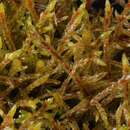en
names in breadcrumbs


Sexual reproduction: Schreber's big red stem moss is a dioecious, pleurocarpous (producing the sporophytes laterally from short, lateral, specialized branches rather that at the stem tip) moss. The spores are shed 9 to 12 months after fertilization [24]. The period of gametangial (structure containing the gametes) development in Schreber's big red stem moss is approximately 7 months for archegonia (female gametophyte) and 9 months for antheridia (male gametophtye). The timing of gametangial development in spring may be influenced by the duration or severity of the winter [24].
Schreber's big red stem moss capsules (A) and spores (B). Wikimedia images By HermannSchachner.
Pleurozium schreberi, the red-stemmed feathermoss[1] or Schreber's big red stem moss,[2] is a moss with a loose growth pattern.[3] The root name pleuro comes from the Latin for ribs, possibly describing how the parts branch from the stem.
The species occurs on the floor of the boreal forests of Canada, Scandinavia and northern Russia; an example of this occurrence is within the black spruce/feathermoss climax forest, sometimes having moderately dense overstory canopy and featuring a forest floor of feathermosses including, Hylocomium splendens and Ptilium crista-castrensis.[4]
In a study of the effect of the herbicide Asulam on moss growth, Pleurozium schreberi was shown to have intermediate sensitivity to Asulam exposure.[5]
Pleurozium schreberi carpeting the floor of black spruce (Picea mariana) and balsam fir (Abies balsamea) forest in New Brunswick, Canada.
Pleurozium schreberi, the red-stemmed feathermoss or Schreber's big red stem moss, is a moss with a loose growth pattern. The root name pleuro comes from the Latin for ribs, possibly describing how the parts branch from the stem.
The species occurs on the floor of the boreal forests of Canada, Scandinavia and northern Russia; an example of this occurrence is within the black spruce/feathermoss climax forest, sometimes having moderately dense overstory canopy and featuring a forest floor of feathermosses including, Hylocomium splendens and Ptilium crista-castrensis.
In a study of the effect of the herbicide Asulam on moss growth, Pleurozium schreberi was shown to have intermediate sensitivity to Asulam exposure.